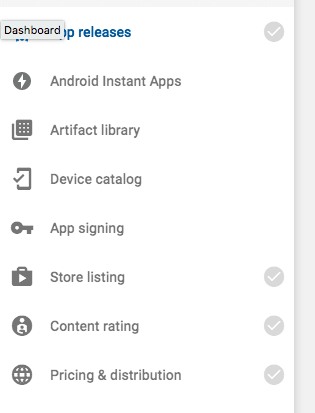For my first post on Dev.to, I want to share my React Native project structure, configurations and some tips. It contains most of the things I've learnt after 1 year of development with React Native, from the creation to the distribution.
I created a Github repository called typescript-react-native-starter that I now use for all my projects.
So I hope it's helpful for other developers who are new with React Native. And you are welcome to make PR :D
Features
I started to use Typescript recently after several projects which made me understand the importance of typed variables. It might take some time to learn at first but it's worth it. You might avoid hours maybe days of debugging thanks to Typescript.
Plus it makes your code self-documenting which is crucial for projects with severals developers.
-
Typescript
-
Flux State management
- Redux: predictable state container
- Redux Persist: offline store
- Redux Saga: side effect model for Redux
- typesafe-actions: create typesafe actions easily
import { action } from 'typesafe-actions';
import * as types from './actionTypes';
export const myAction = payload => action(types.MY_ACTION_TYPE, payload);
-
Navigation
- React Navigation: easy-to-use navigation solution based on Javascript
-
Unit testing
- Unit tests with Jest, Enzyme and react-native-testing-library
- Codecov: coverage report
-
CI/CD
- Run linting pre-commit and unit testing pre-push with husky's hooks
- Placeholder App Icon: useful for uploading your app to beta quickly with Fastlane
- App Icon generator: generate all required sizes, label and annotate icon.
- Placeholder feature graphic and screenshot to upload beta android app quickly
-
Linting
- Tslint configured with Airbnb styles
- Vscode Prettier compatible
-
Internationalization and localization
- react-native-localization: easy to use package for i18n
-
Others
- Cocoapods: iOS dependencies manager
- jetifier: transition tool for React Native 0.60 AndroidX migration
- autobind-decorator: bind your component's functions easily with a decorator
// Before
handleClick() {...}
<button onClick={ this.handleClick.bind(this) }></button>
// After
@boundMethod
handleClick() {...}
<button onClick={ this.handleClick }></button>
Project Structure
The structure I used is inspired from many sources so you might find this familiar. I like to seperate my files by category except for some special ones like App.tsx, store.ts,...
The publishing folder also contains some useful placeholder images to deploy your app.
For example, in order to deploy your app on Google Play, even for Internal Testing, you would have to add screenshots, feature graphics,... It was ok at first but after several projects, it's kinda annoying so I decided to create some placeholder images for that.
├── __tests__ // Unit tests
│ ├── App.test.tsx // App component's tests
│ ├── components
│ │ └── MyComponent.test.txs
│ └── ...
├── android
├── app.json
├── assets // All assets: images, videos, ...
├── index.js
├── ios
├── publishing // Icon, screenshots, preview,... for App Store & Play Store
└── src
├── App.tsx
├── actions // Actions
│ ├── actionTypes.ts // Action types
│ └── app.ts // appReducer's actions
├── components // Components
│ └── MyComponent.tsx
├── constants // Colors, sizes, routes,...
│ └── strings.ts // i18n
├── containers // Screens, pages,...
├── lib // Libraries, services,...
├── index.tsx // Root component
├── reducers // Reducers
│ └── app.ts // appReducer
├── sagas // Redux sagas
├── store.ts
├── types // Type declarations
│ └── index.d.ts
└── utils // Utilities
Useful tips
This section is for completely random but useful tips, feel free to share yours in the comment or make a PR.
NavigationService
You can navigate without navigation prop by using NavigationService from src/lib/NavigationService.ts
import NavigationService from '../lib/NavigationService';
//...
NavigationService.navigate('ChatScreen', { userName: 'Lucy' });
Cocoapod
When you run react-native link and the linked library has podspec file, then the linking will use Podfile. To disable this feature, remove
# Add new pods below this line
from line 24 in ios/Podfile
Static bundle
The static bundle is built every time you target a physical device, even in Debug. To save time, the bundle generation is disabled in Debug
react-native-screens
You can use react-native-screens with react-navigation in order to improve memory consumption
Install and follow steps in
Usage with react-navigation (without Expo)from react-native-screensOpen
./src/index.tsxand uncomment
// import { useScreens } from 'react-native-screens';
// useScreens();
Responsiveness
- Avoid as much as you can "absolute" position and hard values (100, 300, 1680,...) especially for big ones.
- Use flex box and % values instead
- If you have to use hard values, I have this
normalizefunction for adapting hard values accordingly to the screen's width or height. I might upload it on the repository later:
import { Dimensions, Platform, PixelRatio } from 'react-native';
export const { width: SCREEN_WIDTH, height: SCREEN_HEIGHT } = Dimensions.get(
'window',
);
// based on iphone X's scale
const wscale = SCREEN_WIDTH / 375;
const hscale = SCREEN_HEIGHT / 812;
export function normalize(size, based = 'width') {
const newSize = based === 'height' ? size * hscale : size * wscale;
if (Platform.OS === 'ios') {
return Math.round(PixelRatio.roundToNearestPixel(newSize));
} else {
return Math.round(PixelRatio.roundToNearestPixel(newSize)) - 2;
}
}
So now I can use:
// iphone X
normalize(100) // = 100
// iphone 5s
normalize(100) // = maybe 80
// You can choose either "width" (default) or "height" depend on cases:
container = {
width: normalize(100, "width"), // "width" is optional, it's default
height: normalize(100, "height")
}
- Before pushing, test your app on 3 differents emulators: iphone5s (small), iphone 8 (medium) and iphone Xs Max (big)
Beta distribution with Fastlane
- Install fastlane
# Using RubyGems
sudo gem install fastlane -NV
# Alternatively using Homebrew
brew cask install fastlane
iOS
- Open your project Xcode workspace and update your app's
Bundle IdentifierandTeam - Initialize fastlane
cd <PROJECT_NAME>/ios
fastlane init
- Distribute your app
fastlane beta
Android
- Collect your Google Credentials
- Open your project with Android Studio and update your app's
applicationIdinbuild.gradle (Module: app)file - Select
Generated Signed Bundle / APK...from theBuildmenu -
NextthenCreate new...underKey store paththenNextandFinish - The first time you deploy your application, you MUST upload it into Google Play Console manually. Google don't allow to use theirs APIs for the first upload.
- Create your application in the Google Play Console (unlike for iOS Fastlane cannot do that for you)
-
Make sure that these 4 checkmark icons are green
Recommended order:
Pricing & distribution,Content rating,Store listingandApp releasesYou can find the required assets for
Store listingin thepublishing/androidfolder Initialize fastlane
cd <PROJECT_NAME>/android
fastlane init
- Use the Fastfile from
publishing
cp publishing/android/fastlane/Fastfile android/fastlane
- Distribute your app
fastlane beta
There is no official plugin to automatically upgrade android version code (unlike the iOS lane).
Before each deployment, be sure to manually upgrade theversionCodevalue insideandroid/app/build.gradle.
More
- Checkout the Fastlane's beta distribution guide for more details
- Fastlane's documentation for React Native
Apple Store Connect's missing compliance
If you dont' use Fastlane and you don't want to Provide Export Compliance Information at every push , then add this to your Info.plist
<key>ITSAppUsesNonExemptEncryption</key>
<false/>

Note that you might have to set that to <true/> if your app uses encryption








Top comments (10)
How do I make ur react native app stable on different screen size
My react native app on my emulator is okay but when I test it on a smaller screen size the soon doesn't fit the screen
Hi. You are right, I don't know how I can forgot to talk about responsiveness. I will update that soon on my repository. Here are what I do to handle that:
normalizefunction for adapting hard values accordingly to the screen's width or height. I might upload it on the repository later:So now I can use:
Hope this help :D
I'd like to also ask as to how do you deal with system font sizes? Or is that something that should be considered while designing the app beforehand?
I use the function normalize() that I mentionned in the post so I don't have much problems with the font sizes.
Oh, so that's not just for the actual screen size of the phone, but also for font sizes? TIL
Well the function adapt a hard value like 13 depending on the screen sizes for exemple on the iPhone X the fontSize will be 13 but on the iPhone5, the fontSize is 11
Excellent post, trying to use TS on my next project too!
I am getting a 404 on the GitHub link
Ah yes I forgot to update it. Thank you. Here is the link github.com/NewBieBR/typescript-rea...
thanks :)